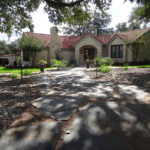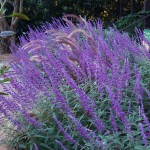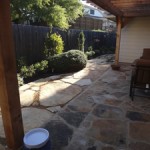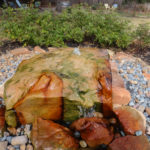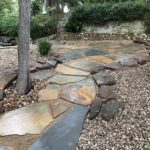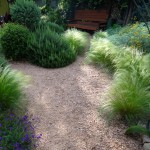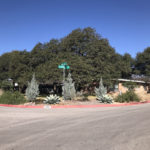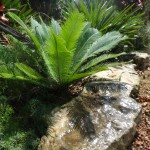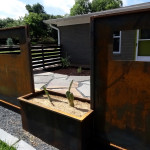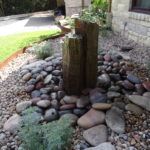
“I’m warnin’ ye ESP, one more ridiculous
pirate analogy in this blog
and I will cutlass yer barrel cacti, if you catch
my drift…savvy?

Pieces of eight, pieces of eight…
This was the scene on Morris Williams golf course the other week. A large “pandemonium” or “company” of our very own, feral Austin Quaker Parrots (Myiopsitta monachus). These birds are also known as the Monk Parakeet. The birds originate from the temperate to subtropical areas of Argentina and surrounding countries in South America. I had hit a very uncharacteristic “non-slice” golf-shot to end up pretty close to these birds, I hopped out of the golf cart with my I-Phone and started snapping, hence the poor image quality. These intelligent birds were feasting on some freshly sewn golf course seed, whilst simultaneously excelling at various Phd programs.

Picture courtesy of Wikipedia My winter Post Oak
The Monk Parakeet is the only parrot that builds a stick nest, in
a tree or on a man-made structure, rather than using a hole in a tree.
There is a huge nest in the light tower across from Cafe Mundi, on
the East side of Austin. So how did these birds end up wild in Austin?
“Arrr…more of a ‘monk’ey man me-self.”
Rumor has it that a “lady” released 10 or 12
of these birds on purpose almost a couple of
decades ago. I often hear them having a
pandemonium on one of the large Pecan or
Post Oak trees around my property, their
shrill calls very distinctive.
“A ‘lady’ released them you say?,
Well yes, I’m a lady, then It was I,
I released the monk parrots!”

Japanese Holly Fern unfurling Cyrtomium falcatum.
The recent moisture has sprung this fern into a growth spurt. Interesting how the leaves are packed in really tight within the curling frond. Holly ferns also makes a great house plants because they can withstand dry air, drafts, and low light levels. Holly ferns are native to Asia.

The pigmentation on the Holly fern leaves is also very unusual with it’s dappled design.

A new horsetail Equisetum arvense emerging from my “bucket bog” looking very Balanese-esque. This has given me some “adornment” ideas for my future 15ft agave stalk wind instrument.
Horsetail reed has a rich history of healing ailments, today, horsetail continues to have medicinal value. The plant’s stems are rich in silica and silicic acids, which help mend broken bones and form collagen, an important protein found in connective tissue, skin, bone, cartilage, and ligaments. Therefore, horsetail is used as a supplement to treat and prevent osteoporosis.

The drizzle this last week also brought a ton of these spiraled chappies out into the open, as well as a few million weeds.
So many weeds…so little time. My granite front bed, beneath
my Vitex tree was under attack from the dreaded dandelions.
It took me an hour to extricate these monsters with their
annoyingly deep, “snapping” tap roots..

Wet Oxialis triangularis – Purple Passion / Shamrock plant – this clump grows under my Giant Timber Bamboo.
Can you tell I am experimenting with my Christmas fish-eyecamera?
I forgot just how “out of touch” you feel when you are using physical film and a manual camera, I have to say that my confidence dropped with every dull sounding “clunk” of the lense. I went to Precision Camera today to pick up the film, fearing the worst, as it turned out, I was pleasantly surprised. Out of my 24 exposure 35mm film, I think I may have 4 or 5 interesting shots, I can live with that as a first attempt with a new fish-eyed “analog” camera.

And here is the green variation Oxalis regnellii in full bloom right now. This plant also makes a great indoor plant.
Desert Willow Trumpet Creeper, Podranea ricasoliana
This plant is also known as Port John’s Creeper, Zimbabwe Creeper. It is a member of the Bignoniaceae family to which our native trumpet creeper also belongs. It however isn’t as invasive as the trumpet creeper and doesn’t come up from ground shoots but it may root by layering where a a vine contacts the soil. It is said to be native to South Africa, mine is sporadically blooming right now for some obscure reason, typically it blooms in the late fall.


I thought I would post the mountain laurel bloom from last week (left).
Here it is this week, with the purple blooms beginning to emerge.
Amazing development in only seven days, I guess that is why they are
short lived, fast to emerge-fast to die, they never seem to last long enough!
The color change from the middle picture to the right picture happened within
two days, and naturally I missed it!
Here is a detail of one of the Mountain Laurel blooms, looking like some Art Deco lamp fixture.

Today I decided I would cut back some of my now rather leggy Gopher plants Euphorbia biglandulosa. The Gopher plant is a shrubby evergreen perennial that looks like something from another planet. This native of the Mediterranean has long, arching stems that are lined with fleshy, grey-green leaves. The sap you see on the right picture is very poisonous if ingested, and there is plenty of it when pruned as you can see. As an experiment I stuck a few of the pruned heads from this plant into the ground of my new middle bed to see if anything will happen. I am not holding my breath.
A few final images in the patch this week:
“I can’t stand it when you cry like this!”
I got so annoyed with this lavender that is some four years old, I decided to trim it back
to within a foot of it’s life. It was looking so bad with a couple of feet of woody growth
then a thin top layer of spears, I had to do it, it was the humane thing to do.
I am hoping it rebounds with a much more compact growth habit.
Fingers crossed.

A Sotol as seen through my “fish eye” lens. “Oh my god, they have discovered warp drive!”

This book-end of a cactus, succulent, errr, flat plant thingymabob is developing a bloom…what is this? Some type of living rock cactus perhaps? A very bizarre plant and equally bizarre bloom on a flat taper stalk. I wait with baited breath!
Wet Artemesia sprawling down one of my man-made hillocks.
Oh, just one more…
Stay Tuned For:
“Ox-Tongue in Cheek”
All material © 2009 for east_side_patch. Unauthorized reproduction prohibited.

























